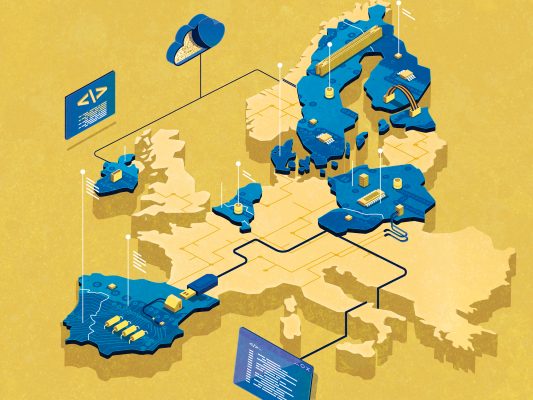The European Commission unveiled this month a two-pronged strategy to reduce its dependency on China and boost its green industries. The Critical Raw Materials Act aims to wean the continent off Chinese critical minerals. The Net-Zero Industry Act is geared at boosting the EU’s production of clean tech equipment by a recent decision to relax strict state aid rules.
Together, the proposals represent Europe’s response to the US pressure against China and to compete with protectionist subsidies included in the US’s Inflation Reduction Act. Although a danger remains that the US’s generous pockets and hard-line approach against China will sow discord, these European moves signal a desire to strengthen the transatlantic alliance.
Start back in August 2022, when the US Congress passed the IRA, which contained gargantuan government subsidies to US industries. Europeans were aghast. Confronted with sky-high energy prices and roaring inflation, they could hear a deafening sucking sound of investments leaving the continent and heading across the Atlantic Ocean. The US subsidies jolted European capitals to reconsider their strict limits on state aid, instrumental in building and preserving the European single market.
At the same time, Vladimir Putin’s weaponization of gas exports woke up the continent to the danger of Chinese-supplied critical raw materials and Beijing’s dominance in green industries, such as solar panels and electric car batteries. If China cut sales of these key products, Europe’s plans for its ecological and digital transition would be at risk of collapse — not unlike the United States’.
How could Europeans condemn Americans for steeling themselves against the same threat they faced? The answer to that question challenged the EU’s status quo, and European capitals began tilting westward. In January, while speaking in Davos, European Commission President Ursula von der Leyen downplayed frictions over the IRA and stressed the need to “de-risk” vis a vis China.
The Biden administration took constructive steps: it began exploring extending some of the IRA’s benefits to European industries. US Trade Representative Katherine Tai had been urging the EU to develop its own, parallel strategy on subsidies and reshoring, saying that the US wanted to “work with our friends and allies to allow us to together build a resiliency and to wean us off some dependencies.” An agreement on critical raw materials would allow the US to extend the IRA’s reach to European industries, indicated US Treasury Secretary Janet Yellen. EU countries began to adhere to the US-led Minerals Security Partnership, aiming to create a like-minded critical raw material “buyers’ club” between democratic countries.
The political breakthrough came on March 10. President von der Leyen went to the White House to meet President Biden, while back home her Commission relaxed state aid rules. Afterward, they produced a statement signaling a transatlantic climate truce. And upon her return to Brussels, the Commission launched the two-pronged legislative proposals.
The Net Zero Industry Act aims to ensure that European produces at least 40% of European demand for green products by 2030. EU governments will be able to match subsidies provided in other countries “where there is a real risk of investments being diverted away from Europe,” according to European Commissioner Margrethe Vestager.
The Critical Raw Materials Act aims to supply Europe’s green industries with crucial inputs. European mining and refining must cover at least 10% of the EU critical raw materials by 2030. That would be a giant feat for a continent that spent decades outsourcing most of the extraction and production.
Key provisions have China written all over them. If a foreign country has more than 65% of the market, its companies will have little chance of winning a public contract in the EU. For context, Beijing controls more than 80% EU market share in the solar sector.
Permitting will be sped up. It can take up to 15 years to get the green light for a new mining project in Europe. Under the Critical Raw Materials Act, mines designated as strategic must receive a decision on permits within two years.
Critics question whether Europe can achieve its stated goals. Environmentalists have vowed to oppose projects to mine lithium and other minerals, citing the danger to water and nature preserves. Business leaders from Solvay, Merck, and Dow warn that the Net Zero Industry Act offers too little funding and is too complex to compete against the US’s $369 billion of green tax incentives and subsidies.
Even so, the European proposals signal a U-turn in economic policymaking — and a potential transatlantic alignment. On both sides of the Atlantic, the love affair with free markets and globalization is fading. Instead of market-driven decision-making, we are entering an era of strategic planning with democracies moving to onshore and subsidizing critical industries.
The transition will be rocky and perilous. Divergences over how hard to hit China could re-emerge. The US takes a hard line, while European officials continue to consider Beijing both a “rival” and a “partner.” But both Brussels and Washington are working hard not to let their support for green tech deteriorate into a counter-productive and protectionist subsidy race. If they work together, they could shore up the democratic world’s shift to clean tech.
Otto Lanzavecchia is an Italian journalist for Formiche.net and Decode39. He focuses on international affairs, tech and society, energy, and climate change.
Bandwidth is CEPA’s online journal dedicated to advancing transatlantic cooperation on tech policy. All opinions are those of the author and do not necessarily represent the position or views of the institutions they represent or the Center for European Policy Analysis.





